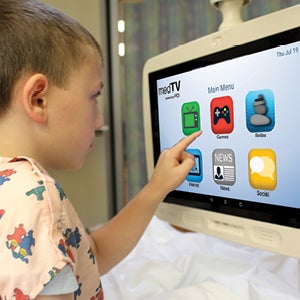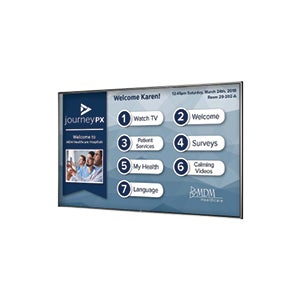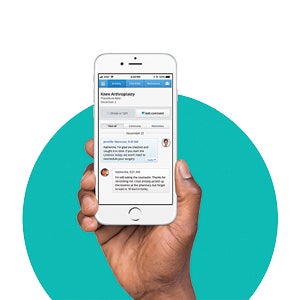New trends in patient 'edutainment' systems

In an environment where a patient is apt to feel powerless, providing entertainment, relaxation and education on their condition as well as offering tools to manage their experience can be empowering.
“Hospitals are leveraging technology, integrating systems and applications into a single, user-friendly solution that empowers patients to be educated about their health while being entertained,” says Kevin Colores, general manager at TeleHealth Services, Raleigh, N.C.
Patient education and entertainment systems allow hospital staff to deliver and document health education to patients, and to train patients on how to access their health records online. They also can be used to conduct surveys to gather data and improve the patient experience.
Going mobile
The in-room TV is still the primary connection for patients and family members. Thus, hardware is evolving to meet the demand for both large and small displays. For instance, LG Business Solutions, Lincolnshire, Ill., provides large-format, smart hospital TVs along with a personal smart TV on an articulating arm.
“More information is being displayed on these TVs, driving the need for more screen space to display various bits of information along with programming. For example, one section of a screen may show programming while another may show patient and clinician information or patient interactive options,” says Tom Mottlau, director of health care at LG Business Solutions. “Incorporating a larger display in the patient’s room eliminates the need for a second patient portal display in the room. Our new smart hospital TVs with webOS fit these applications.”
However, vendors also are offering more mobile solutions. “Our clients are making our patient engagement applications available via several devices so patients and families can access education, entertainment and concierge-like services on their own terms and on the device type they prefer. This includes the in-room TV, bedside tablets and patient-owned mobile devices,” says Meghan Seus, vice president of product marketing at SONIFI Health, Los Angeles.
eVideon Inc., Grand Rapids, Mich., offers a patient companion tablet, which can be linked to the company’s Patient Experience Platform on the backend to place all relevant information at a patient’s fingertips. The touchscreen and on-screen keyboard aspects of the tablet provide a better experience than can be had on a TV for things such as email, web browsing and playing games, according to Scott King, chief technology officer.
“The tablet also lets hospitals deploy additional apps alongside the platform — apps that will only run on an android or iOS (iPad) tablet,” King says. “What’s more, a built-in camera provides apps such as video interpreter services, remote clinical consults and virtual visitors. Some of these benefits also may be achieved with a patient’s own device.”
pCare, New York City, sees growing interest in using voice commands, thus integrating patient experience platforms with services such as Alexa, Google and Nuance. Consequently, the company is exploring ways to add voice command capabilities to its solutions, according to Dave Bennett, chief executive officer.
Yet, there are big hurdles to overcome to ensure HIPAA compliance and protection of patient privacy. “We have a prototype under development that will address these regulatory issues,” Bennett says. “Success will require commitment and collaboration from Amazon, Google and other players.”
While smartphones, tablets and other devices offer important benefits, they can be harder to manage and create an additional burden on hospital staff, Bennett notes. “Devices must be cleaned, as part of infection control, and charged after use. For an already overtaxed workforce, adding such tasks to the daily to-do list can inhibit the adoption of patient experience solutions.”
Electronic whiteboards that use real-time locating system (RTLS) technology are a relatively new development in patient education and entertainment systems, says Heather Wood, vice president of patient engagement at MDM Healthcare, Ponte Vedra Beach, Fla. “Using data fed from the electronic health record (EHR) and other data sources, the TV displays information pertinent to the patient’s care as soon as a care team member enters the patient’s room. That includes the care team member’s name and role. And as soon as the care team member walks out, the screen returns to its previous function. However, using a pillow speaker, the patient can access the electronic whiteboard at any time.”
Balancing act
The goal of these systems is to educate in an entertaining way, and to provide access to the familiarity of home.
One of the entertainment apps that SONIFI Health has developed is Staycast. This proprietary solution uses Google Chromecast to provide patients and their families with the familiarity of home by enabling them to stream content — Netflix, Hulu and more — from their mobile apps to the TV in the hospital room. They can do this safely and securely, without their subscription log-in credentials ever leaving their personal device.
Anthony Brooke, vice president of strategy for product, partnerships and data analytics at GetWellNetwork, Bethesda, Md., says that most new bedside systems fall into two camps: entertainment or education. “Many educational offerings are available in quantity but lack integration to the clinical workflow. So, if a provider does not directly prescribe the education, it’s up to the patient to find the relevant information.”
Brooke says GetWellNetwork provides entertainment as well as educational materials that are targeted to the patient’s point in their journey. The apps proactively message the patient, assess comprehension, and adjust the educational plan and alert clinical staff accordingly. “In 2020, we plan to support a big push into helping a patient’s family take an active role in the patient’s outcome.”
Data collection is another benefit of the latest patient education and entertainment systems, which connect with EHR and RTLS. In fact, data capture and documentation are critical to success, according to Wood. “Tracking every touch point — every time a nurse prescribes a patient education or relaxation video, every time a patient completes a video, each movie watched, each patient request, every survey response and each time the preferred language is changed — we need to measure it.”
Real-time data is highly valuable to both patients and providers, according to Lynn Schutte, marketing communications coordinator at PDi Communication Systems Inc., Springboro, Ohio. Displays can show information such as the names of providers or a patient’s most recent vitals. Also, pushing a patient satisfaction survey through the interactive TV can help health networks identify and address concerns before patient discharge. “Knowing which patients are dissatisfied with certain issues helps staff identify areas and take immediate remedial action,” Schutte says. “This show of attentiveness may reflect well in patient surveys.”
Most system providers agree there is little difference between installations for hospitals and small, off-site facilities; it’s more an issue of scale. On the other hand, Brooke says some of the greatest innovations are being undertaken by small, rural hospitals that are driven not only by need, but by their ability to be nimble. “Their limited market and income means they have to get creative,” Brooke says. “They are more likely, for example, to adopt bedside telemedicine solutions that permit specialists to remotely consult through patient education and entertainment systems.”
While technologies continue to advance, collaborating with hospitals to solve challenges with innovative strategies to improve patient care will always be a priority, says Colores. To that end, TeleHealth Services has introduced a new version of its interactive patient engagement system featuring a simpler, more intuitive interface. It uses familiar icons on the TV monitor similar to those on mobile phones and tablet devices.
“This next-generation system includes patient prompts and reminders along with game-like incentives to further encourage patient engagement and interaction,” Colores says. “It serves as a digital whiteboard and integrates with the EHR, which allows patients to access educational videos through a patient portal after discharge. The system also allows patients to cast their own on-demand content from any mobile device regardless of the operating system.”
New installations
New patient education and entertainment systems have been installed in hospitals across the nation with positive results.
For example, a recent installation by PDi Communication Systems Inc. includes apps that provide patient access to Epic MyChart Bedside for personal patient health records and facility web information. The custom browser displays only the hospital information webpage without allowing the patient to go anywhere else on the web. “These applications meet essential needs for engaging patients and internet security at the facility,” Schutte says.
SONIFI Health has installed systems at several Texas Health Resources hospitals, including a new flagship facility in Frisco, according to Seus. Patients and their families can watch movies on-demand; view assigned educational materials; receive alerts when new materials are available; access a medication education library; and get answers to frequently asked questions, such as visiting hours. In-room digital whiteboards present updated information on the day’s schedule, patient care teams and education assignments — with input from the EHR.
eVideon Inc. has installed a system at the Rocky Mountain Regional VA Medical Center, Aurora, Colo., that encompasses inpatient and outpatient displays across all service lines. The system is integrated with the VA’s EHR. Veterans are provided with distraction therapies such as HD-TV delivered over Ethernet network, multiple relaxation options and sleep aid content. Patient education is delivered to HD-TVs based on assignment in the EHR.
“One unique aspect is the 30-bed spinal cord injury unit,” King says. “Every bed is equipped with assistive devices for interactive control without the use of a person’s hands. In 19 of the 30 beds, the eVideon system is integrated with environmental control units that allow veterans to control their interactive experience with voice commands, retinal eye movements and other modalities.”
Additional tools
Wood says the market is trending toward using additional tools that integrate with artificial intelligence (AI). Capturing data and using it to help patients is the focus.
“One example is our partnership with HealthTalk AI (Ashburn, Va.),” she says. “The company uses real-time data to send information, requests and key questions to a specific patient at a critical time, so a hospital knows why their patients are being readmitted.”
Neal Lorenzi is a freelance writer and regular contributor based in Mundelein, Ill.

INTERACTIVE ACTIVITIES
medTAB offers patients an interactive entertainment solution. PDi Communication Systems Inc.

EASY ACCESS
JourneyPX features a user-friendly interface that makes it easy for patients to meet their in-room needs when staying at a medical facility. MDM Healthcare

PATIENT PREFERENCE
These patient engagement applications are available via several devices so patients and families can access education, entertainment and concierge-like services on their own terms and on the device type they prefer. SONIFI Health

TOUCHING BASE
With GetWell Loop, care teams can engage all patients across their care journey through automated virtual check-ins. GetWellNetwork

NO PAIN
These interactive patient engagement and education systems teach about and address pain management via relaxation videos and music used by many hospitals to help relieve stress and pain. Avidex (formerly TeleHealth Services)

ENHANCED EXPERIENCE
The LG UT672M display improves the patient experience in health care environments. LG Business Solutions

CONTINUOUS CARE
This meds-to-beds program supports continuity of treatment for patients through the discharge process. pCare




